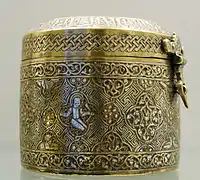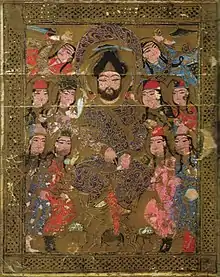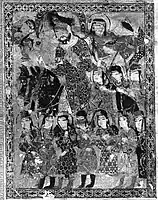| Badr al-Din Lu'lu' بَدْر الدِّين لُؤْلُؤ | |||||
|---|---|---|---|---|---|
 Probable portrait of Badr al-Din Lu'lu'. Manuscript illustration from the Kitāb al-Aghānī of Abu al-Faraj al-Isfahani (Feyzullah Library No. 1566, Istanbul). He is wearing a Turkic dress, and is identified by his name "Badr al-Din Lu'lu'" on the țirāz bands | |||||
| Ruler of Mosul | |||||
| Rule | 1234 – 1259 | ||||
| Predecessor | Nasir ad-Din Mahmud | ||||
| Born | c. 1178 | ||||
| Died | 1259 | ||||
| |||||
| Religion | Sunni Islam | ||||
Badr al-Din Lu'lu' (Arabic: بَدْر الدِّين لُؤْلُؤ) (c. 1178-1259) (the name Lu'Lu' means 'The Pearl', indicative of his servile origins) was successor to the Zengid emirs of Mosul, where he governed in variety of capacities from 1234 to 1259 following the death of Nasir ad-Din Mahmud. Originally a slave of the Zengid ruler Nur al-Din Arslan Shah I, he was the first Middle-Eastern mamluk to transcend servitude and become an emir in his own right, founding the dynasty of the Lu'lu'id emirs (1234-1262), and anticipating the rise of the Bahri Mamluks of the Mamluk Sultanate of Egypt by twenty years (but postdating the rise of the Mamluk dynasty in India). He preserved control of al-Jazira through a series of tactical submissions to larger neighboring powers, at various times recognizing Ayyubid, Rûmi Seljuq, and Mongol overlords. His surrender to the Mongols temporarily spared Mosul the destruction experienced by other settlements in Mesopotamia.
Rise to power as Atabeg of Mossul (1211-1234)
Lu'lu' was an Armenian convert to Islam,[2] and a freed slave in the household of the Zangid ruler Nur al-Din Arslan Shah I.[3] Recognized for his abilities as an administrator, he rose to the rank of atabeg and, after 1211, was appointed as atabeg for the successive child-rulers of Mosul, Nur al-Din Arslan Shah II and his younger brother, Nasir al-Din Mahmud. Both rulers were grandsons of Gökböri, Emir of Erbil, and this probably accounts for the animosity between him and Lu'lu'. In 1226 Gökböri, in alliance with al-Muazzam of Damascus, attacked Mosul. As a result of this military pressure, Lu'lu' was forced to make a submission to al-Muazzam. Nasir al-Din Mahmud was the last Zengid ruler of Mosul, he disappears from the records soon after Gökböri's death. He was killed by Lu'lu', by strangulation or starvation, and his killer then formally began to rule in Mosul in his own right.[4][5]
Ruler of Mosul (1234-1259)
In 1234 Lu'lu' minted the first coins in his own name. Following his usurpation his new position as ruler of Mosul was recognised by the Abbasid Khalif, Al-Mustansir, who bestowed upon him the praise name al-Malik al-Rahim (The Merciful King). During his reign he sided with successive Ayyubid rulers in his disputes with other local princes. In 1237 Lu'Lu' was defeated in battle by the former army of the Khwarazmshah and his camp was thoroughly looted. Lu'lu' was in conflict with Yezidi Kurds in his territories, he ordered the execution of one Yezidi leader, Hasan ibn Adi, and 200 of his followers in 1254.[7] The territory controlled by Badr al-Din Lu'lu' was quite extensive and reached it maximum in 1251, including Kurdistan, Sinjar, Jazirat ibn Umar, Nusaybin in the west, and the Khabur district as far as Qarqisiya on the Euphrates to the east.[8]
Lu'lu' built extensively in his domain, improving the fortifications of Mosul, the Sinjar Gate bearing his device survived into the 20th century, and constructing religious structures and caravanserais. He built the shrine of Imam Yahya (1239) and the shrine of Awn al-Din (1248).[9] The ruins of his palace complex, known as the Qara Saray (1233-1259), were visible until the 1980s.[10]
The rule of Badr al-Din Lu'lu' seems to correspond to a period of cultural bloom and religious tolerance. He sponsored the arts, including the publication of several illustrated manuscripts. He also seems to have maintained a balance between the Muslim Sunnis and Shiites, providing support for the Shiites in his primarily Muslim Sunni subjects, and seems to have been tolerant of Mosul's large Christian community. This may have been a concious policy, which provided stability and longevity to his reign.[6]
Mongol invasion
.jpeg.webp)
Badr al-Din Lu'Lu', who also had maintained good relations with the Abbasid Caliph in Baghdad or the Ayyubids of Syria depending on the circumstances, supported the Mongol invasion of Mesopotamia and recognized the authority of the Mongols as early as 1245, thus avoiding destruction for his city of Mosul.[11]
During the final stages of the Mongol invasion of Mesopotamia, in 1258, while about 80 years old, Badr al-Din went in person to Meraga to offer his submission to the Mongol invader Hulagu.[12] Badr al-Din helped the Khan in his following campaigns in Syria. Mosul was spared destruction, but Badr al-Din died shortly thereafter in 1259.[12] Badr al-Din's son Isma'il ibn Lu'lu' (1259-1262) continued in his father's steps, but after the Mongol defeat in the Battle of Ain Jalut (1260) against the Mamluks, he sided with the latter and revolted against the Mongols. Hulagu then besieged the city of Mosul for nine month, and utterly destroyed it in 1262.[12][13]
Family
- Isma'il ibn Lu'lu', the son of Badr al-Din Lu'lu, ruled Mosul for only three years (1259 - 1262) before his city was lost to the Mongols.[14]
- A daughter of Lu'lu' was set to marry Aybak, as his second wife after Shajar al-Durr. However, Aybak was killed before the marriage could take place.
Contemporary craftsmanship
Mosul under Badr al-Din Lu'lu' was characterized by fine crafstmanship, particularly in the areas of woodworking and metalworking, with the production of some of the best inlaid metalworks of the period.[15] Lu'Lu' personnally supported the production of inlaid metal ewers, and several examples have remained to this day.[9] The Spanish Muslim traveller Ibn Said reported in 1250:
Mosul … there are many crafts in this city, especially inlaid-brass vessels, which are exported (and presented) to rulers, as are the silken garments woven there
 Coin of Badr al Din Lu'lu', Mosul, 1210–1259. The central legend starts with "Lu'Lu'" at the top (Arabic: لُؤْلُؤ). British Museum
Coin of Badr al Din Lu'lu', Mosul, 1210–1259. The central legend starts with "Lu'Lu'" at the top (Arabic: لُؤْلُؤ). British Museum Wooden door of the Great Mosque of Amadiya (13th century); the inscription mentions sultan Badr-addin Ibn Lulu Ibn Abdullah, the happy sultan, and the merciful king.
Wooden door of the Great Mosque of Amadiya (13th century); the inscription mentions sultan Badr-addin Ibn Lulu Ibn Abdullah, the happy sultan, and the merciful king. Homberg ewer, by Ahmad al-Dhaki al-Mawsili. Inlaid Brass with Christian Iconography. probably Mosul, dated 1242–43.[16]
Homberg ewer, by Ahmad al-Dhaki al-Mawsili. Inlaid Brass with Christian Iconography. probably Mosul, dated 1242–43.[16] Inlaid brass tray of Badr al-Din Lu'lu'. Mosul, 13th cen. V&A.[17]
Inlaid brass tray of Badr al-Din Lu'lu'. Mosul, 13th cen. V&A.[17] Cylindrical lidded box with an Arabic inscription recording its manufacture for the ruler of Mosul, Badr al-Din Lu'lu
Cylindrical lidded box with an Arabic inscription recording its manufacture for the ruler of Mosul, Badr al-Din Lu'lu.jpg.webp) Mausoleum of Yahya Abu al-Qasim, built in Mosul by Lu'Lu' in 1239.[9]
Mausoleum of Yahya Abu al-Qasim, built in Mosul by Lu'Lu' in 1239.[9]
Literature
The Book of Songs (1218-1219)
During this period, the atabeg Lu'lu' appears prominently in the 1218-1219 edition the Kitāb al-aghānī ("Book of Songs"), probably made in Mosul. The whole edition consists in 20 volumes, four of them now being in the National Library in Cairo (II, IV, XI, XIII), two more in the Feyzullah Libray, Istanbul (XVII, XIX), and the last one in the Royal Library, Copenhagen.[18] and had several miniatures, only six of which have remained.[19]
In the miniatures, Lu'lu' wears the Turkic military furred hat, the Sharbush (Harbush).[19] He also wears a gold brocaded Turkic tunic (qabā` turki), with țirāz arm bands on which his name is clearly inscribed.[20] He has red leather boots with stamped gold decorations.[21] Most of his attendants wear the Turkic dress, with Turkic coat, boots and headress.[21]
_by_Ab%C5%AB_al-Faraj_al-I%E1%B9%A3bah%C4%81n%C4%AB.jpg.webp) Lu'lu' with musicians and male attendants. Kitāb al-aghānī, Mosul, 1218-1219. Vol IV. Cairo, Egyptian National Library, Ms Farsi 579.[19]
Lu'lu' with musicians and male attendants. Kitāb al-aghānī, Mosul, 1218-1219. Vol IV. Cairo, Egyptian National Library, Ms Farsi 579.[19] Lu'lu' with two senior figures, possibly a turbaned Christian bishop and a Turkish military leader with a fur-trimmed hat. Kitāb al-aghānī, Mosul, 1218-1219. Vol XI. Cairo, Egyptian National Library, Ms Farsi 579.[19]
Lu'lu' with two senior figures, possibly a turbaned Christian bishop and a Turkish military leader with a fur-trimmed hat. Kitāb al-aghānī, Mosul, 1218-1219. Vol XI. Cairo, Egyptian National Library, Ms Farsi 579.[19] Lu'lu' as enthroned atabeg with attendants. Kitāb al-aghānī, Mosul, 1218-1219. Vol XVII. Istanbul, Millet Library, Ms Feyzullah Efendi 1566.[19]
Lu'lu' as enthroned atabeg with attendants. Kitāb al-aghānī, Mosul, 1218-1219. Vol XVII. Istanbul, Millet Library, Ms Feyzullah Efendi 1566.[19] Lu'lu' on horse with attendants. Kitāb al-aghānī, Mosul, 1218-1219. Vol XIX. Istanbul, Millet Library, Ms Feyzullah Efendi 1565.[19]
Lu'lu' on horse with attendants. Kitāb al-aghānī, Mosul, 1218-1219. Vol XIX. Istanbul, Millet Library, Ms Feyzullah Efendi 1565.[19]_of_Abu-l-Farraj_al-Isfahani%252C_Mosul_1217-19%252C_David_Collection.jpg.webp) Lu'lu' on galloping horse. Kitāb al-aghānī, Mosul, 1218-1219. Vol XX. Royal Library, Copenhagen, Denmark, No. 168.[22]
Lu'lu' on galloping horse. Kitāb al-aghānī, Mosul, 1218-1219. Vol XX. Royal Library, Copenhagen, Denmark, No. 168.[22]
The Book of Theriac (1225-1250)
A mid-13th century edition (second quater of the 13th century, i.e. 1225-1250) of the manuscript Kitâb al-Diryâq, attributed to Mosul, is known from the Nationalbibliotek in Vienna (A.F. 10).[26] Although there is no mention of a dedication in this edition, the courtly paintings are quite similar to those of the court of Badr al-Din Lu'lu' in the Kitab al-Aghani (1218-1219), and may be related to this ruler.[27][28]
._Mid_13th_century_(Turkoman_soldiers_detail).jpg.webp) Turkoman soldiers (detail). Book of Antidotes of Pseudo-Gallen. Probably northern Iraq (Mosul). Mid 13th century.[29]
Turkoman soldiers (detail). Book of Antidotes of Pseudo-Gallen. Probably northern Iraq (Mosul). Mid 13th century.[29].jpg.webp) Ancient physicians, Kitab al-diryaq, Vienna AF 10
Ancient physicians, Kitab al-diryaq, Vienna AF 10.jpg.webp) Kitab al-diryaq, Vienna AF 10
Kitab al-diryaq, Vienna AF 10
References
- ↑ Flood, Finbarr Barry (2017). A Turk in the Dukhang? Comparative Perspectives on Elite Dress in Medieval Ladakh and the Caucasus. Austrian Academy of Science Press. p. 231 & 246 Fig.10.
- ↑ Islamic art and architecture 650-1250 By Richard Ettinghausen, Oleg Grabar, Marilyn Jenkins, pg, 134
- ↑ Court and Cosmos: The Great Age of the Seljuqs - MetPublications - The Metropolitan Museum of Art. Metropolitan Museum of Art. 2016. p. 61.
- ↑ Gibb, pp. 700-701
- ↑ Patton, pp.152-155
- 1 2 Snelders, Bas (2010). Identity and Christian-Muslim Interaction: Medieval Art of the Syrian Orthodox from the Mosul Area. Peeters. pp. Extract. ISBN 978-90-429-2386-7.
Patton argues that in addition to Badr al-Din Lu'lus ordering and sponsoring the foundation of numerous social and religious institutions in Mosul, his energetic patronage of the arts was probably part of a conscious policy aimed at securing the loyalty of the city's population and ensuring that they would not turn their backs on him in favour of one of his opponents. This egalitarian treatment of the Muslim Sunnis and Shiis should certainly beseen in this light, but also his comparatively tolerant attitude towards Mosul's large Christian community. As Patton argues, 'Lu'lus skill at maintaining the support of all groups while especially favouring none is a remarkable achievement which explains not only the duration of his reign, but probably the great efflorescence of the arts in his reign as well. After the death of Badr al-Din Lu'lu' in 1259, however, the prosperous period and cultural bloom in the Mosul area soon came to an end.
- ↑ Kreyenbroek and Rashow, p. 4
- ↑ Snelders, Bas (2010). Identity and Christian-Muslim Interaction: Medieval Art of the Syrian Orthodox from the Mosul Area. Peeters. pp. Extract. ISBN 978-90-429-2386-7.
At the height of his rule, around the year 1251, realm of Lu'lu' included Kurdistan, Sinjar, Jazirat ibn cUmar, Nasibin or Nisibis (Nusaybin), and the Khabur district as far as Qarqisiya on the Euphrates.
- 1 2 3 4 Snelders, Bas (2010). Identity and Christian-Muslim Interaction: Medieval Art of the Syrian Orthodox from the Mosul Area. Peeters. pp. Extract. ISBN 978-90-429-2386-7.
- ↑ Bloom and Blair (eds.), p. 249
- ↑ Snelders, Bas (2010). Identity and Christian-Muslim Interaction: Medieval Art of the Syrian Orthodox from the Mosul Area. Peeters. pp. Extract. ISBN 978-90-429-2386-7.
He cultivated close relationships with the Abbasid Caliph in Baghdad, the Ayyubids of Syria, and the Mongols, respectively, shifting his loyalty depending on the political situation of the day. In 1245, he recognized the authority of the Mongols and supported their invasion of Mesopotamia, thus saving Mosul from being sacked by Mongol invaders, a fate suffered by so many cities at the time.
- 1 2 3 Bretschneider, E. (5 November 2013). Mediaeval Researches from Eastern Asiatic Sources: Fragments Towards the Knowledge of the Geography and History of Central and Western Asia from the 13th to the 17th Century: Volume II. Routledge. p. 122. ISBN 978-1-136-38056-3.
- ↑ Bloom and Blair (eds.), pp. 249, 499
- ↑ Spengler and Sayles, p. 140
- ↑ Court and Cosmos: The Great Age of the Seljuqs - MetPublications - The Metropolitan Museum of Art. Metropolitan Museum of Art. 2016. p. 265 ff.
- ↑ Court and Cosmos: The Great Age of the Seljuqs - MetPublications - The Metropolitan Museum of Art. Metropolitan Museum of Art. 2016. p. 265.
- ↑ Court and Cosmos: The Great Age of the Seljuqs - MetPublications - The Metropolitan Museum of Art. Metropolitan Museum of Art. 2016. p. 62.
- ↑ Ettinghausen, Richard (1977). Arab painting. New York : Rizzoli. pp. 62–63. ISBN 978-0-8478-0081-0.
- 1 2 3 4 5 6 Rice, D. S. (1953). "The Aghānī Miniatures and Religious Painting in Islam". The Burlington Magazine. 95 (601): 128–135. ISSN 0007-6287.
- ↑ Badr al din Lu'lu' name of his tiraz bands
Flood, Finbarr Barry (2017). A Turk in the Dukhang? Comparative Perspectives on Elite Dress in Medieval Ladakh and the Caucasus. Austrian Academy of Science Press. p. 231 & 246 Fig.10. - 1 2 Yedida Kalfon Stillman, Norman A. Stillman (2003). Arab Dress: A Short History : from the Dawn of Islam to Modern Times. Leiden, Netherlands: Brill. p. 67. ISBN 9789004113732.
Fig.23: Frontispiece of Kitab al-Aghani from Iraq, ca. 1218/19 depicting the enthroned atabeg Badr ai-DIn Lu'lu' 'Abd Allah wearing a gold brocaded (Zarkash), lined qabā` turki with gold Tira'z armbands on which his name is clearly inscribed. His boots are of red leather with gold, probably stamped, vegetal decoration. On his head is a fur-trimmed sharbush. Most of his attendants wear Turkish coats, boots, and a variety of kalawtat (Millet Kiitiiphanesi, Istanbul, Feyzullah Efendi ms 1566, folio Ib).
- ↑ Court and Cosmos: The Great Age of the Seljuqs - MetPublications - The Metropolitan Museum of Art. Metropolitan Museum of Art. 2016. p. 61.
- ↑ Ettinghausen, Richard (1977). Arab painting. New York : Rizzoli. p. 91. ISBN 978-0-8478-0081-0.
- ↑ Ettinghausen, Richard (1977). Arab painting. New York : Rizzoli. p. 162. ISBN 978-0-8478-0081-0.
- ↑ Yedida Kalfon Stillman, Norman A. Stillman (2003). Arab Dress: A Short History : from the Dawn of Islam to Modern Times. Leiden, Netherlands: Brill. pp. Fig.19. ISBN 9789004113732.
Fig.19: 19. Frontispiece of a mid-13th-century manuscript, probably from Mosul of the Kitāb al-Diryāq of Pseudo-Galen showing an informal court scene in the center with a seated Turkish ruler (on left) wearing a fur-trimmed, patterned qaba' maftulJ, with elbow-length tiraz sleeves and on his head a sharbilsh. Most of his attendants wear aqbiya turkiyya and kalawta caps. Workman depicted behind the palace and riders in the lower register wear the brimmed hat with conical crown known as saraquj. On the saraquj of one workman is a crisscrossed colored takhftfa with a brooch or plaquette pinned in the center of the overlap. The women on camels in the lower righthand corner wear a sac-like head veil kept in place by a cloth 'isaba (Nationalbibliothek, Vienna, ms A. F. 10, fol. 1).
- ↑ Pancaroǧlu, Oya (2001). "Socializing Medicine: Illustrations of the Kitāb al-diryāq". Muqarnas. 18: 155–172. doi:10.2307/1523306. ISSN 0732-2992.
- ↑ Pancaroǧlu, Oya (2001). "Socializing Medicine: Illustrations of the Kitāb al-diryāq". Muqarnas. 18: 169. doi:10.2307/1523306. ISSN 0732-2992.
- ↑ "Kitab al-diryaq (Book of Antidotes) - Discover Islamic Art - Virtual Museum". islamicart.museumwnf.org. Islamic Art Museum.
It may potentially be related to the courtly milieu of Badr ad-Din Lu'lu' (died 1259), successor to the Zengid emirs of Mosul, who is known to have commissioned other manuscripts.
- ↑ Ettinghausen, Richard (1977). Arab painting. New York : Rizzoli. p. 91, 92, 162 commentary. ISBN 978-0-8478-0081-0.
In the painting the facial cast of these Turks is obviously reflected, and so are the special fashions and accoutrements they favored. (p.162, commentary on image p.91)
Bibliography
- Bloom, J.M. and Blair, S.S. (eds.) (2009) The Grove Encyclopedia of Islamic Art and Architecture, Volume I: Abarquh to Dawlat Qatar, Oxford University Press, Oxford
- Gibb, H.A.R. (1969) [1962]. "The Aiyubids". In Setton, Kenneth M.; Wolff, Robert Lee; Hazard, Harry W. (eds.). A History of the Crusades, Volume II: The Later Crusades, 1189–1311 (Second ed.). Madison, Milwaukee, and London: University of Wisconsin Press. pp. 693–714. ISBN 0-299-04844-6.
- Kreyenbroek, P.G. and Rashow, K.J. (2005) God and Sheik Adi are Perfect, Harrassowitz Verlag, Wiesbaden
- Patton, D. (1988) Ibn al-Sāʿi's Account of the Last of the Zangids, Zeitschrift der Deutschen, Morgenländischen Gesellschaft, Vol. 138, No. 1, pp. 148–158, Harrassowitz Verlag Stable URL: https://www.jstor.org/stable/43377738
- Spengler, W.F. and Sayles, W.G. (1992) Turkoman Figural Bronze Coins and Their Iconography: The Artuquids, Clio's Cabinet, Lodi
External links
- Imam Awn al-Din Mashhad (Mosul) Archived 2008-05-07 at the Wayback Machine
- Imam Yahya ibn al-Qasim Mashhad (Mosul) Archived 2011-05-25 at the Wayback Machine
- Sittna Zaynab Mausoleum (Sinjar) Archived 2010-12-14 at the Wayback Machine
.jpg.webp)
._Mid_13th_century.jpg.webp)